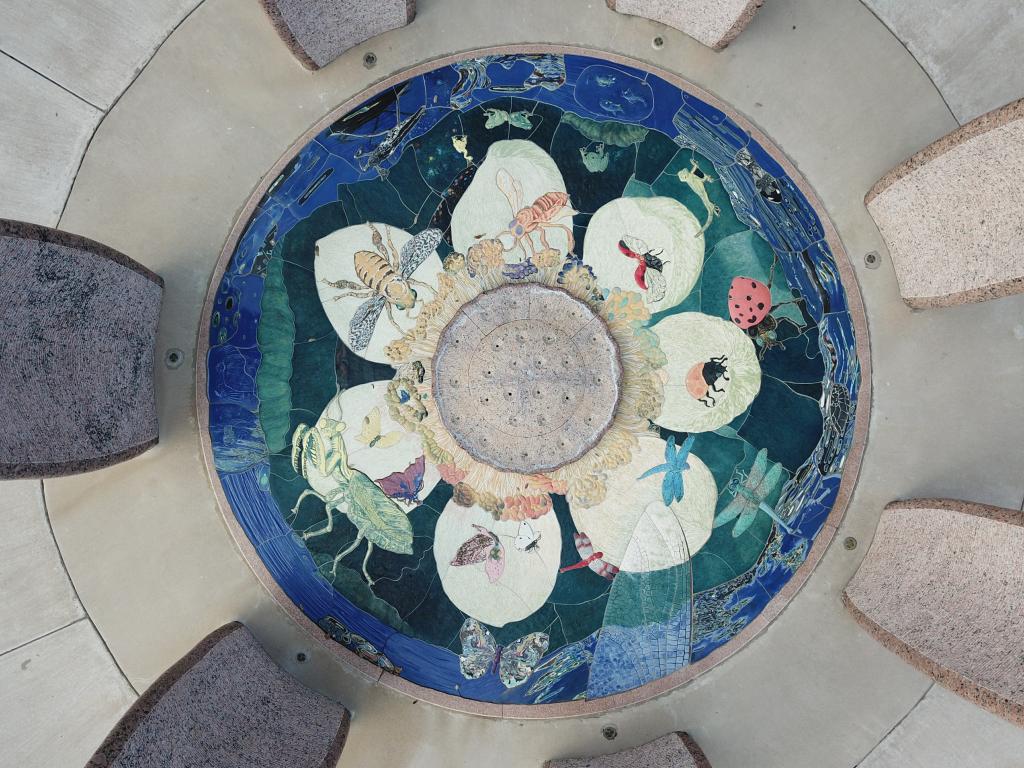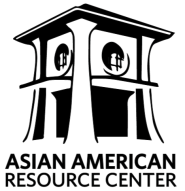AARC Home | Events | Exhibits | Rentals | Senior Program | Youth Program
The AARC’s Community Art Exhibit Program displays artworks year round that celebrate the diverse and dynamic cultural heritage, history, identity and creativity of Asian American Pacific Islanders. Exhibits are displayed on a quarterly schedule.
Current/Upcoming Exhibits and Programs
Check back to learn more about our Spring/Summer 2025 Exhibits
Permanent and Semi-Permanent Installations
- Lotus
-
Lotus by Sunyong Chung and Philippe Klinefelter, 2013
granite, handmade ceramic tiles
Lotus is a large site specific sculpture created by Art in Public Places commissioned artists Sunyong Chung and Philippe Klinefelter for the Asian American Resource Center (AARC), and is located in the entrance plaza overlooking heritage live oaks.
Chung created an intricate and lively 12’ diameter mosaic of a lotus, made of hand-colored and hand-crafted dimensional tiles, which Klinefelter surrounded with seven 9’ tall hand-carved granite “petals” gracefully reaching toward the sky. Klinefelter also carved the lotus’s seed pod at the center of the mosaic from granite, which doubles as a gently flowing fountain. According to feng shui principles, the placement of the fountain near the AARC entrance creates positive chi, or energy, for the building. The lotus, native to Asia, was chosen as inspiration for the sculpture because of its symbolic attributes of harmony, purification and healing.
- Prayer Phone
-
Prayer Phone | Semi-Permanent Art Installation
Prayer Phone, a handmade altar with a disconnected phone, is an invitation to the public to “call” their deceased loved ones while giving offerings and prayers. This project reflects a common custom of many Asian traditions: commemorating ancestors and venerating the spirit world.
Two essential elements compose this installation. The old fashioned phone is a symbolic artifact that represents humanity’s desire to connect and communicate with others. Its historic form evokes passage of time. By contrast, the spiritual act of lighting incense symbolizes the following: sacredness when the element of air is ignited, purification of the environment’s energy, and blessings in return for offerings. These two elements combine to help connect the earthly to the heavens.
This project is inspired by an episode of This American Life featuring stories about Telephone of the Wind in Otsuchi Town, a small seaside town in northeastern Japan. An iconic English telephone phone booth connected to nowhere was repurposed, and people began “calling” family members lost during the tsunami caused by the 2011 Great Japan Earthquake. Telephone of the Wind became a public space for people to grieve for their lost loved ones. In response, Prayer Phone shares in the deep tradition of respecting spirits and coexisting with entities beyond the physical realm, as well as providing a physical space and an outlet to feel connected with the departed.
Past Exhibits
- Past 2025 Exhibits
-
Peelander-Yellow: Let's Play on Planet-Yellow!!!
Mamie Raynaud: Chinatown in Three Acts
- Past 2024 Exhibits
-
Saffron Creative House: Artistic Redirection
Kelly Lan, Bo Feng Lin: Kiss Papercuts Goodbye
Photo-Voice: Imagining an Age-Friendly Austin
Diane Hong: Vessels - Handle with Care
- Past 2023 Exhibits
-
Jae-Eun Suh's "Ensemble Archives"
Finding Creativity in Resistance: The Legacy of Silk Club
Perlas Ng Austin: A Celebration of the Central Texas Filipino Community Through the Arts
- Past 2021 - 2022 Exhibits
-
ArtsResponders: Social Practice Responds to COVID-19 Featuring Lizzie Chen and Kengo
Tradition's Rebirth in Modern Austin
Creative Highlights Video Series
- Past AARC Exhibits
-
Colonized Women: Reclaiming Our Indigenous Roots
Reinventions, A Senior Art Show
Page last updated: April 9, 2025

